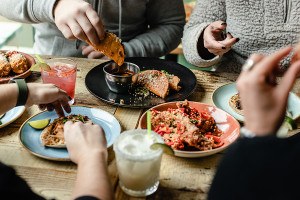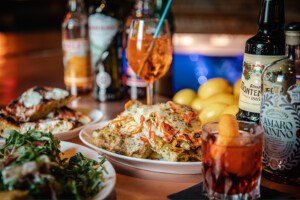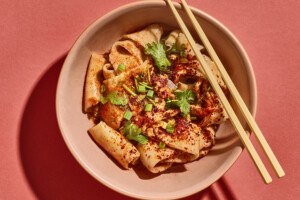Dining Out: Latin Quarter
Just months after opening, Orinoco feels as if it’s always been there, or should have been. Right, it’s Venezuelan, a cuisine unfamiliar to Boston, let alone the South End. But there are Latin American touchstones you’ll recognize, including really stellar rice and beans, and the fashionable fusion often called Nuevo Latino—a melding of various Central and South American cuisines with Asian touches.
Just months after opening, Orinoco feels as if it’s always been there, or should have been. Right, it’s Venezuelan, a cuisine unfamiliar to Boston, let alone the South End. But there are Latin American touchstones you’ll recognize, including really stellar rice and beans, and the fashionable fusion often called Nuevo Latino—a melding of various Central and South American cuisines with Asian touches. As at Oleana, which opened with a focus on Turkish food but offered hints of Mediterranean and a sort of fusion that’s all chef Ana Sortun’s own, it takes exactly one Orinoco meal to make Venezuelan and Nuevo Latino cuisine go from something you might never have thought of eating to something indispensable.
Orinoco is on a part of Shawmut that’s impossible to drive to and even worse for parking. But the neighborhood is ripe for a friendly walk-to restaurant: Orinoco’s renovated storefront manages to mix New England turn-of-the-century Main Street with the homey Venezuelan taguarita—a kind of lively roadside joint that the stylish native Venezuelan owner, Andres Branger, wanted to evoke. The tin ceiling and walls with framed vintage photos of Venezuela; the old etched seltzer bottles, wooden dolls, and baskets on the shelves; and the pastel wooden booths and mismatched bentwood chairs all make for a cool, happening place that’s perfect for hanging out. Given the waits for dinner (the restaurant is small, and doesn’t take reservations), you might well be doing just that—thankfully accompanied by a friendly crowd, and well looked after by the affable, upbeat Branger.
The dishes, too, straddle homey and happening. Some work better than others, and there are small disappointments throughout the menu, including a noticeable absence of vegetables other than plantains, which all too accurately mirrors the home country. But everything tastes agreeable, and is executed with a high level of professionalism. The happy vibe and plain reliability of the food—not to mention reasonable prices—are why I think Orinoco will likely become a South End fixture.
My favorite dishes came straight from tradition, chef Carlos Walter Rodriguez later told me. Many are based on mechada, shredded long-cooked beef, which seems to be the hamburger of Venezuela. The menu describes pabellón criollo ($12.95)—pulled beef—as “Venezuela’s most folkloric dish,” and Rodriguez told me that every grandmother (including his, in his native Caracas) has its components simmering on the stove, ready to be ladled out for any visitor.
As a main course the shredded pot roast is served with the other must-have element at Orinoco: black beans, made from a recipe Rodriguez learned from Doug Rodriguez, the celebrity chef he worked with in Miami (no relation), and the man responsible for putting “Nuevo Latino” into the U.S. foodie vocabulary. The secret recipe his teacher entrusted him with is Cuban, not Venezuelan, and it’s not so secret anymore: The Orinoco chef Rodriguez gave it to Chris Kimball, founder of Cook’s Illustrated and an early regular at Orinoco, who called them the world’s best black beans when he published the recipe. When Kimball joined me at Orinoco one night for dinner, he happily went through a large side order ($4.25) along with his main course—and so did I, even though I’d already finished the portion that came with the pabellón criollo, and the sweet, soft fried plantains.
The shredded beef is also the mainstay of several other dishes, serving as a filling for empanadas ($7.95)—smaller and less greasy than usual, showing the typically careful technique—and for arepas ($5.95), the cushiony griddle-baked corn cakes that are split and filled to create Venezuela’s national sandwich. Truth be told, I found the arepas, which Branger has touted as the reason he opened the restaurant (he couldn’t find any here), disappointing. Maybe it was because I’ve had them in both Venezuela and an arepa restaurant in Palo Alto opened by Jean-Paul Coupal, a successful Caracas restaurateur for whom Rodriguez also worked. Orinoco’s arepas are made with Venezuelan cornmeal and are properly fluffy in the middle, but are both thicker and oilier than I remember and thus a good deal harder to keep together with two hands, whether filled with beef or with guayanés, a mild white cheese with a consistency between mozzarella’s and Camembert’s.
While beef may be the star, chicken is prominent, too, shredded for guiso. Like the mechada, the breast meat is simmered with sweet spices, tomato juice and paste, raw sugar, Worcestershire sauce, and chopped olives and raisins for two days. Rodriguez told me Venezuelans say his guiso tastes like Christmas. It’s pretty hard to resist anytime, whether bound with mayonnaise and chilled as arepa filling or mixed with cilantro, layered with avocado, and stuffed into an arepa called reina pepiada ($5.95)—the restaurant’s bestselling dish. Rodriguez has compensated for a lack of fresh vegetables in Venezuelan cooking with several original salads, including a year-round signature creation with endives, hearts of palm, blue cheese vinaigrette, and bacon-wrapped dates ($7.50), and a light chicken-breast salad with grapes, feta, and sherry vinaigrette ($7.75). The grilled breast for the salad was nicely flavored, if dry.
Overcooked chicken and fish, in fact, seem to be something of a hazard. Fish appears mostly in specials, including a mahi mahi that’s frequently on the menu ($19), breaded with ground plantain chips and baked with paprika and chili, and served over a shredded oxtail stew with tomato escabeche and a port wine reduction. The blend of fish and meat, mildly spicy and mildly sweet, is pleasant, and the dish is a success, but the fish is so well done it’s pretty dry. Along with that mahi mahi, specials like the seared tuna with ginger and mango mojo (garlic-citrus vinaigrette) also veer from traditional Venezuelan to Nuevo Latino.
I found the chicken guiso completely irresistible in polvorosa de pollo ($13), a flaky, buttery dough baked in a muffin shape that’s filled with the chicken and glazed with raw sugar caramelized with sweet spices and sweet hot pepper. It’s like a Venezuelan version of a Chinese pork bun, with a dough that potpies dream of. I could have it all the time. It even came with greens.
Desserts are minimal: a firm, eggy flan ($4.95) with not much caramel and the consistency of cream cheese; and a molten chocolate cake ($4.25), served inelegantly in a tinfoil cup, that shows off the deep and superior flavor of Venezuelan dark chocolate, which is among the world’s very best. The chocolate will sell you on Venezuelan food if nothing else does. But that’s unlikely at Orinoco.


